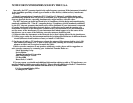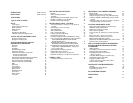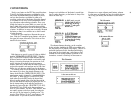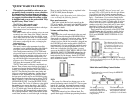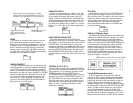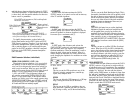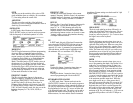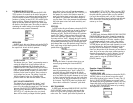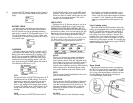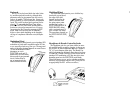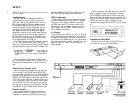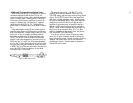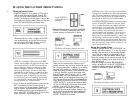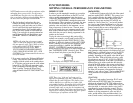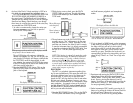
POLY/MONO
In FUNCTION mode, this button activates the [DATA
ENTRY] section so its controls can set the keyboard to
play polyphonically (up to 16 notes simultaneously) or
monophonically (one note at a time).
PITCH BEND
In FUNCTION mode, this pair of buttons activate the
[DATA ENTRY] section so its controls can program the
range and "smoothness" of the [PITCH] wheel. If the
RANGE is set to zero, the [PITCH] wheel will have no
effect.
RANGE
This lets you program the maximum amount of pitch
bend from no effect (0) to plus or minus an octave
(12 semitones). The numbers in the programming
display indicate how many semitones the wheel can
change the pitch in each direction. The [RANGE]
may only be adjusted when the [STEP] is set to zero.
If [STEP] is at 1 or higher, the [RANGE] is automati-
cally fixed at 12 semitones. Remember that a zero
setting turns off the pitch bend.
STEP
This permits you to set the size of the increments by
which the wheel changes the pitch. A setting of zero
(0) will cause perfectly smooth pitch bending. Each
unit above zero represents the number of semitones
by which the pitch will "jump" as you move the
wheel. The maximum setting of 12, for example, will
cause the wheel to change the pitch in a single,
1 octave jump.
PORTAMENTO
In FUNCTION mode, these 3 buttons activate the
[DATA ENTRY] section so its controls can be used to
set portamento (glide) and glissando (stepped glide)
effects, and to control certain sustain characteristics of
the keyboard. The particular effects available will
change, depending on whether the DX7 is in Poly or
Mono mode.
MODE
When the keyboard is in Mono mode, this lets you
select "FINGERED PORTA" or "FULL TIME PORTA"
functions. Fingered Portamento is a glide that occurs
only when you hold one key down and then press
another while holding the first. Full Time Portamento
gives you the glide from one note to the next even
when you release one key before pressing the next.
When the keyboard is in Poly mode, this lets you
select "SUS-KEY P FOLLOW" or "SUS-KEY P
RETAIN". In Sustain-Key Pitch Follow mode, if you
play a note or chord and then play another note or
chord, the sustain from the original note/chord glides
to the pitch of the most recently played note/chord.
In Sustain-Key Pitch Retain mode, the pitch of the
new note or chord glides from that original pitch(es)
without disturbing the sustain of the original note or
chord.
GLISSANDO
When the Glissando feature is turned ON, the glide
in pitch occurs in discrete steps. This effect is best
heard with a slower rate and when two widely sepa-
rated notes are played one after the other. When
Glissando is turned OFF then normal Portamento
(continuous glide) is available.
TIME
This sets the time of the Portamento or Glissando
effect. A setting of 0 produces no effect, while a set-
ting of 99 produces the longest (slowest) pitch
changes. This is contrary to the operation of most DX7
rate controls whose fastest setting is 99. You don't
have to change the Time to zero to turn the effect off.
Instead, once an effect is selected, it can also be
turned On and Off by plugging an FC-4 or FC-5 foot
pedal into the PORTAMENTO jack on the rear panel;
stepping on the pedal then turns ON the portamento.
NOTE: For [MIDI] information, see page 55.
EDIT RECALL
This button activates the DATA ENTRY [YES] and
[NO] buttons so they can be used to recall a voice that
you had been editing in the event you inadvertently
leave the editing mode and select another voice to play
To "recapture" or recall the edited voice, press [FUNC-
TION], then [EDIT RECALL], then answer [YES] to the
two display prompts "Edit Recall?" and "Are You Sure?"
VOICE INIT
The Voice Initialize button lets you create a neutral
starting point for programminq a new voice. After you
select VOICE INIT from the FUNCTION mode by press-
ing the button and then answering [YES] to the two
display prompts, the DX7 sets itself to the EDIT mode. A
neutral "voice" then exists with no modulation, algo-
rithm 1, operator 1 output level at 99 and all others off,
"square" envelopes, and all frequency ratios at 1.00.
CART FORM
NOTE: Since the format of a RAM cartridge used for
other purposes, such as DX1 performance memories,
will vary' from that of a cartridge used for voice memo-
ries, make sure you observe the following procedure
when storing or saving DX7 internal voices into such a
cartridge.
The Cartridge Format button lets you "initialize" all
the voices in a RAM cartridge much like you initialized
the single voice in the edit buffer using the [VOICE
INIT] button. It is like a cartridge "eraser." To use this
function you first have turn off the hardware memory
protect switch on the cartridge, then turn off the soft-
ware [MEMORY PROTECT-CARTRIDGE] function
on the DX7. Then press [CART FORM] and answer
[YES] to the two displayed prompts. THINK BEFORE
YOU DO THIS; IF THERE WERE ANY VOICES YOU
WANTED ON THAT CARTRIDGE, THEY WILL BE
GONE FOREVER. (You can load one or more cartridge
9



